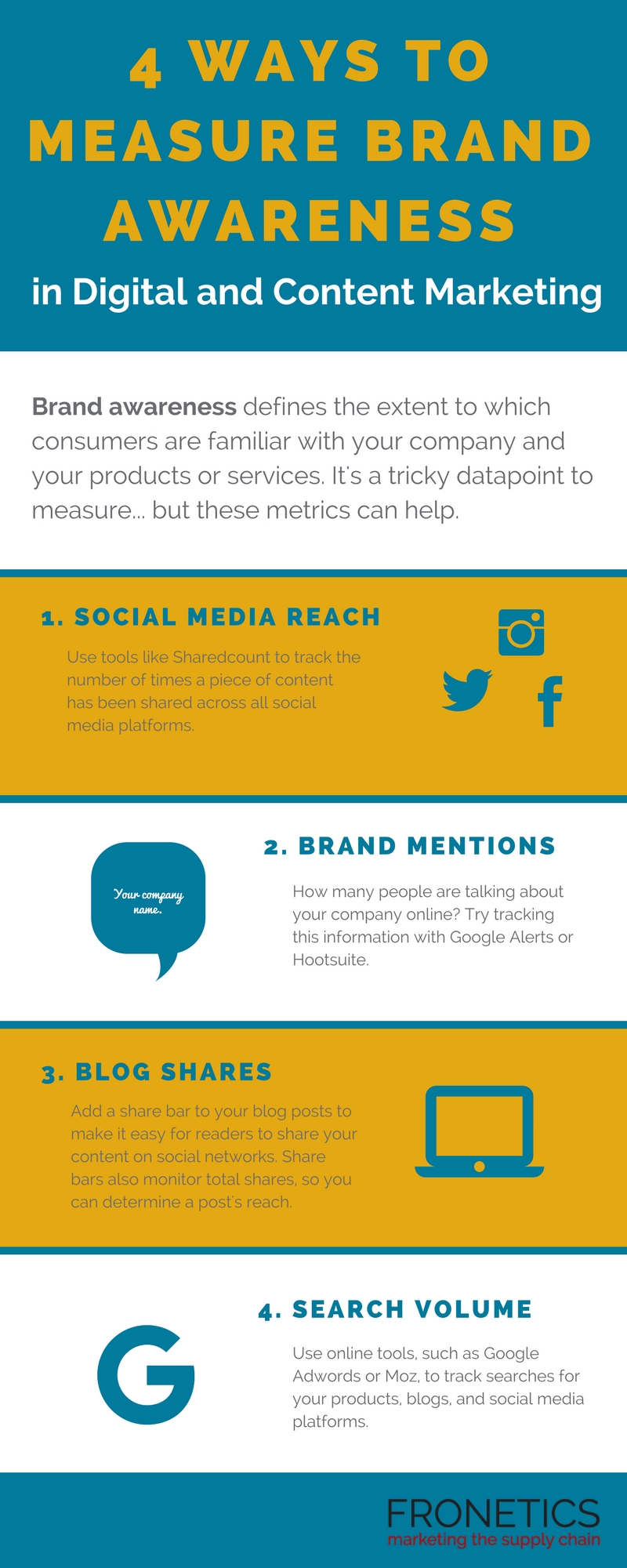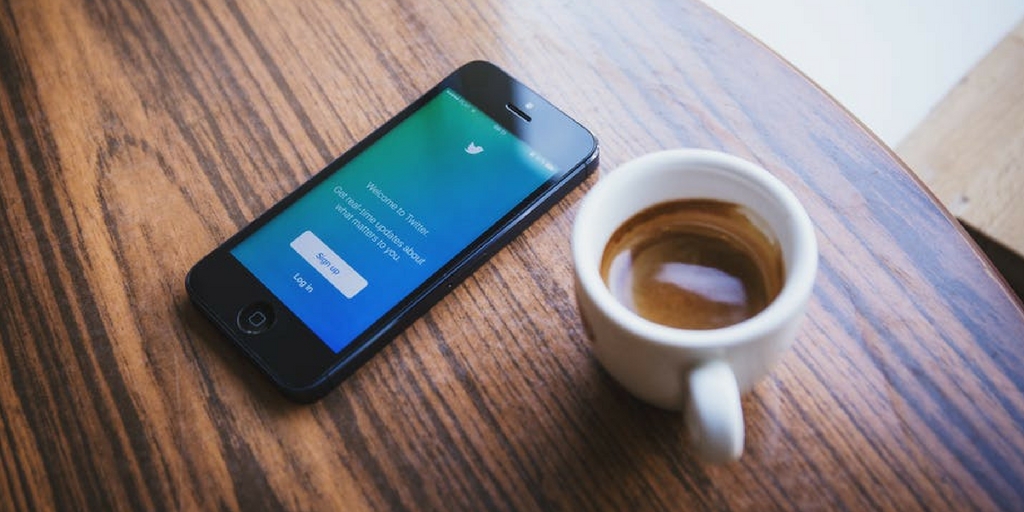
by Fronetics | Mar 1, 2018 | Blog, Content Marketing, Logistics, Marketing, Strategy, Supply Chain
Brand awareness is key in optimizing your content marketing efforts but can be challenging to quantify. Here are four metrics to help you measure brand awareness.
Brand awareness is the extent to which potential customers recognize a brand and associate it with specific products and services. Making the public aware of your company is a long-term goal of content marketing. Through social media, blogs, and other platforms, content marketing works to create brand awareness and strengthen trust with target customers. Drawing the public’s attention to — and heightening their knowledge of — your business ultimately generates leads that turn into sales, after all, which is the end marketing objective.
But it has been notoriously difficult to quantify how effective your content marketing strategy is (and, more specifically, how far your brand awareness reaches). Unlike vanity metrics, which are easy to quantify, measuring brand awareness takes more than just a simple calculation. But that doesn’t mean you shouldn’t take the time to measure brand awareness.
Understanding the value of brand awareness gives companies insight into how well their content marketing strategy is working to generate leads and drive sales. As marketing ROI guru Jim Lenskold writes:
“The value of brand awareness is the equivalent of half of a $100 bill. Unless you know where to find the other half, there really is no value. Brand awareness does not have a financial value on its own but is part of the collective effort necessary for marketing to drive incremental sales.”
Brand awareness is key to reaching and influencing potential customers. Here are some metrics to help your measure your brand awareness.
4 ways to measure brand awareness

(Made with Canva)
Ultimately, the more aware audiences are about your brand, the more likely they are to buy your products or services. From familiarity grows trust, which only helps to strengthen your brand and create new relationships with potential customers.
Taking the time to measure brand awareness will help to maximize the success of your content marketing strategy and increase leads. These four metrics will give you a good indication of how familiar your target audiences are becoming with your company.
Related posts:


by Fronetics | Feb 27, 2018 | Blog, Content Marketing, Current Events, Marketing, Social Media
Also in social media news February 2018: Facebook is developing more sophisticated chatbots, Twitter’s increased character count leads to more tweets, and Instagram introduces a new content publishing beta for businesses.
The Olympics aren’t the only thing to keep an eye on this month. The results from the fourth quarter of 2017 show that social media sites are going for the gold when it comes to customer engagement.
Updates to the most popular sites have included longer character counts, more advanced conversational skills with chatbots, and new tools for easier sharing. All of these changes are working to improve user experience and help keep users active on the biggest sites.
Here’s your social media news for February 2018.
Instagram launches content publishing beta for businesses
Instagram’s latest update allows businesses to schedule photo posts, view posts they’ve been tagged in, and view other business profiles. Prior to this update, users would have to use a third-party tool to publish posts to the site. “This change helps businesses manage their organic presence more effectively,” writes Instagram on its business blog. This new feature is also open to Facebook Marketing Partners.
Facebook boosts local news posts
In a continued effort to increase customer engagement, Mark Zuckerberg shared the latest changes to Facebook’s News Feed. The site will now boost local events and news stories from high-quality sources. “We’re making a series of updates to show more high-quality, trusted news. Last week we made an update to show more news from sources that are broadly trusted across our community. Today our next update is to promote news from local sources,” writes Zuckerberg. The updates to News Feed are rolling out in the U.S., with plans to expand to other countries later this year.
Twitter launches Sponsored Moments
Twitter introduced a new sponsorship opportunity, Sponsored Moments, in which advertisers can run tweets designed around a specific event or theme. Similar to other in-stream sponsorships, advertisers can promote the moment to their specific target audience and expand their reach beyond the content partner’s existing followers. Twitter is hoping these changes will help advertisers be relevant “in the moment” and create opportunities for a more organic marketing reach.
Facebook developing new chatbots with better conversational skills
The Verge reports that Facebook is working on more sophisticated chatbots with a “consistent personality” and the ability to carry on better conversations. Feedback from Facebook’s FAIR lab showed that customers were unhappy with chatbots’ ability to provide context-based responses and their programmed responses, like “I don’t know,” when faced with questions they can’t answer. Facebook’s new research is looking for patterns in large datasets that will allow chatbots to converse in a more natural human dialogue.
Snapchat hits 187 million daily active users
Snap’s Q4 2017 Earnings Report showed that Snapchat gained 8.9 million daily active users during the last quarter, bringing its total to 187 million daily active users. While still not reaching Instagram and Facebook’s user numbers, this growth shows the largest increase in users since 2016. This increase included 3 million new users from outside of the U.S., a market Snapchat has just recently focused on expanding into.
Twitter’s increased tweet character count leads to more tweets
Back in November, Twitter increased its tweet size to 280 characters. Though most tweets aren’t using the additional characters, the platform has seen an increase in tweets. CEO Jack Dorsey stated that the recent expansion hasn’t actually changed the length of messages people are sending out — but it has led to more engagement.” The increased engagement has come from more retweets and mentions, higher follower rates, and less abandonment of tweets.
Facebook updates branded content policies
Facebook will no longer allow publishers to take money for posting media they didn’t create or weren’t involved in creating. These updates to the platform’s branded content policies also prohibits publishers from placing ads in video, audio or visual content and states that all branded content may only be posted using the branded content tool and has to feature the proper disclosures.
Related posts:


by Fronetics | Feb 26, 2018 | Blog, Content Marketing, Current Events, Logistics, Marketing, Social Media, Supply Chain
The second phase of Facebook News Feed changes boosts local news to strengthen community engagement.
Facebook has been busy making lots of changes to its algorithm and prioritizing what users want from the social media platform. Our recent blog post discussed the first phase of Facebook News Feed changes early this year. The second phase was just released January 29.
Mark Zuckerberg posted, “Starting today, we’re going to show more stories from news sources in your local town or city. If you follow a local publisher or if someone shares a local story, it may show up higher in News Feed.” The new emphasis on local news will begin in the U.S. and will expand to users in other countries later this year.
Civic engagement is key.
All of recent Facebook News Feed changes have centered around user engagement. Zuckerberg’s post talks a lot about the research his company has done to provide the best possible user experience and, in turn, to push for increased involvement.
“There’s a lot of research that suggests that people who read local news are more engaged in their community and they’re more likely to engage in civic improvements. The more informed you are about issues in your community, the more empowered you are to get involved and make a change,” writes Zuckerberg.
Back in January 2017, Zuckerberg went on the “Great American Road Trip,” where the CEO traveled to 23 U.S. states to spend time with everyday people and to gain insight into how Facebook might help local communities. The result? Zuckerberg has unveiled many changes that directly reflect an emphasis on civic engagement and using the power of Facebook to improve connection with local communities.
Trustworthy news.
Zuckerberg says he has directed his product teams to prioritize news that is “trustworthy, informative, and local.” Facebook will begin to survey users on the trustworthiness of media outlets and rank news sources accordingly. These changes continue to promote what Zuckerberg refers to as “meaningful” posts.
All of these changes are a part of a broader strategy for the News Feed and Facebook community. Facebook has declared that it will be prioritizing of content from friends and family and with this new phase, local news will also top that list.
What do Facebook News Feed changes mean for your business?
Businesses have been clamoring to keep up with the decline in organic reach from the first phase of Facebook News Feed changes. With the local news now taking priority behind more personal content, business pages are falling further down the Facebook News Feed. With more of an emphasis on person-to-person interactions, there’s less room overall for Page content.
But don’t give up on Facebook just yet. For smaller businesses, these changes could potentially boost user reach because of their concentrated reader population. Stories that are opened or shared in a tight geographic area will be ranked higher in the News Feed. So, if you’re looking to increase Page visits, make sure your newer content incorporates local news and events. This will (hopefully) catch the eye of local residents and users and push your content higher up in the News Feed.
Has your business been affected the Facebook news feed changes? We’re all working to keep up with the new algorithms and how they impact our business pages. Let us know in the comments.
Related posts:


by Fronetics | Feb 22, 2018 | Blog, Content Marketing, Logistics, Marketing, Social Media, Supply Chain
Twitter bots may get you more followers and retweets, but artificial influence isn’t a healthy indicator of marketing performance.
In this age of influencer marketing, in which followers and retweets are all-important indicators of marketing success, a new phenomenon is emerging: Twitter bots.
According to a recent New York Times article, these computer programs are generally run by “shadowy companies that sell Twitter followers and retweets to celebrities, businesses, and anyone who wants to appear more popular or exert influence online.”
These bots essentially constitute large-scale identity theft, as they use the personal data — including names, profile pictures, and hometowns — of real twitter users. According to recent research from the University of Southern California and Indiana University, “as many as 48 million of Twitter’s reported active users — nearly 15% — are automated accounts designed to simulate real people.” Bot producers count on the economy of online influence, with businesses desperate to monetize a mass audience.
Why are Twitter bots around?
The temptation for businesses to buy followers is strong. Amplification bots, the specific type of Twitter bot most often favored by businesses, promise follows, retweets, and likes for those who buy them, boosting the visibility and “amplifying” the influence of buyers.
“This virtual status is a real-world currency,” say the New York Times writers, as follower counts play a role in determining “how potential customers evaluate businesses or products.”
But as tempting as it may be, paying for followers can get you a lot more — or less — than you bargained for.
The bad news
For one thing, Twitter and other social media sites explicitly forbid buying or selling followers or retweets. While social media companies are more apt to penalize sellers than buyers, if you’re paying for followers, your business is engaging in what can best be described as shady practices.
While companies that sell bots describe their services as legitimate, these claims are shaky at best. They often promise “discretion,” but there’s no guarantee that their client records will remain private.
“It’s fraud,” says British rower and Olympic gold medalist James Cracknell, who regrets purchasing 50,000 followers. “People who judge by how many likes or how many followers, it’s not a healthy thing.”
The bottom line
Cracknell’s statement points to an important, though often overlooked truth about influencer marketing: While quantity of followers and amplification may be fruitful in the short-term, artificial influence isn’t a healthy indicator of market performance. It will ultimately be detrimental to your reputation, a far more important and illusive currency than followers.
“I tell anyone and everyone who ever asks that it’s a total scam,” says Marcus Holmlund, a freelance writer formerly tasked with buying followers for an international modeling agency. “It won’t boost their engagement.”
And there’s the bottom line: While businesses are under constant pressure to increase their social media presence, and bots carry a powerful lure, they are ultimately an ineffective scam.
Related posts:


by Fronetics | Feb 21, 2018 | Blog, Content Marketing, Logistics, Marketing, Supply Chain
These 5 steps will help you identify topic clusters for your business that improve your search engine visibility and drive traffic to your website.
As search engines adjust their algorithms to be more sophisticated, marketers have the opportunity to structure content strategically to optimize website search rankings. We’ve written in detail about this new reality in our writing for SEO series.
One of the best ways to strategically structure your content is with the topic cluster model, in which broad cornerstone content is contained on pillar pages, and related subtopics are contained in cluster content. Each grouping of subtopics and corresponding pillar page is called a topic cluster.
Learn more about topic clusters and pillar content here.
What is a topic cluster?
This structure is intended to build authority and influence for your business in the eyes of search engines and visitors. Effectively using a topic cluster structure is the best way to drive relevant traffic to your website.
First you need to identify your pillar content. HubSpot’s Leslie Ye sums up her philosophy of choosing pillar content, saying, “Ask yourself this: would this page answer every question the reader who searched X keyword had, AND is it broad enough to be an umbrella for 20-30 posts?”
The key takeaway here is that your core topics need to be broad enough to encompass a fair amount of content, narrow enough to allow you to fully address the topic with your content, and, most importantly, they need to be in an area of expertise for your business.
So how do you identify topic clusters strategically? Below are five steps to get you started.
5 steps to identify topic clusters
1) Chart out five to ten primary issues that your target buyer persona faces. You can do this by running interviews, conducting surveys, and researching within online communities like Quora to gather your data.
2) Group each of the issues into broad topic areas.
3) Using keyword research, flesh out each of the core topics with subtopics.
4) Audit your historical content, and map it to align with each of the core topics and surrounding subtopics.
5) Assess where your content makes the strongest cases. Those are your core topics.
Related posts:


by Fronetics | Feb 20, 2018 | Blog, Content Marketing, Current Events, Logistics, Marketing, Social Media, Supply Chain
One of 2018’s fastest growing marketing trends is influencer marketing. Companies will increase their influencer marketing budget to keep up with the competition.
You’ve probably heard the buzzword by now: Influencer marketing seems to be on the tip of every marketer’s tongue these days. Linqia’s latest report, The State of Influencer Marketing 2018, shows that B2C companies are already taking full advantage of this marketing trend. Their report shows that 86% of B2C marketers used influencer marketing in 2017, and 92% of marketers that tried it found it to be effective.
B2B marketers, on the other hand, have been slower to adopt this new marketing trend. Influence 2.0 – The Future of Influencer Marketing Research Report 2017 showed that only 11% of B2B marketers have an ongoing influencer program.
To understand why influencer marketing is becoming so popular and why B2B companies need to jump on the trend, let’s start with the basics.
What is influencer marketing?
Influencer marketing is a form of marketing in which focus is placed on influential people, rather than the target market as a whole. Marketers identify individuals that have influence over potential buyers and create marketing campaigns and activities around these influencers.
For example, Microsoft teamed up with National Geographic last year to launch an influencer marketing campaign, called “Make What’s Next.” The technology giant leveraged some of the most famous adventure photographer influencers on Nat Geo’s Instagram for the campaign. The objective was to bring awareness to young women with interest in science, technology, engineering and math (STEM). By utilizing Nat Geo’s most heavily followed female photographers, Microsoft was able to access a built-in following.
Why influencer marketing works.
Influencer marketing is extremely effective because of three key components:
- Social reach: Influencers can reach millions of followers (and consumers) through their social media channels, websites, and blogs.
- Original content: Influencers work with marketers to produce original content for your brand.
- Consumer trust: Through their existing, strong relationships with their audiences, influencers have a built-in level of trust and can influence consumer opinions.
Content marketers are working overtime to update their content marketing strategies to include influencer marketing campaigns. Consumers no longer want to hear from brands about their products; they want someone they trust to recommend products and services. This is where influencer marketing comes in to play.
Marketers across industries found influencer marketing to be so effective in 2017, that 52% of are planning programs that leverage multiple types of influencers (celebrities, top-tier bloggers, micro-influencers) in 2018.
Where do you begin?
Instagram should be your starting point. According to new research, influencer marketing on Instagram will have generated over $1 billion by the end of 2017, with significant annual growth going forward. With more than 700 million users, Instagram’s platform allows influencers to easily share photos and videos with their followers. Product promotion has never been easier.
Boxed Water turned to Instagram influencer marketing to market its philanthropic campaign, The ReTree Project. The company paired with social influencers, like actors Aidan Alexander and Jaime King, and YouTube star Megan De Angelis, to spread the word about their new campaign. These popular Instagram users asked consumers to post a photo with the hashtag #ReTree and, in turn, Boxed Water would plant two trees for every photo posted. Just one month after launching the campaign, Boxed Water generated more than 2,600 posts with the hashtag.
With 39% of marketers planning to increase influencer marketing budget this year, B2B companies are quickly seeing the leverage that influencers can have over their target audiences. By pairing your products or services with the right influencer, marketers can easily tap into thousands of potential consumers, increasing website traffic and leads.
Have you tried influencer marketing? How was your experience?
Related posts:











